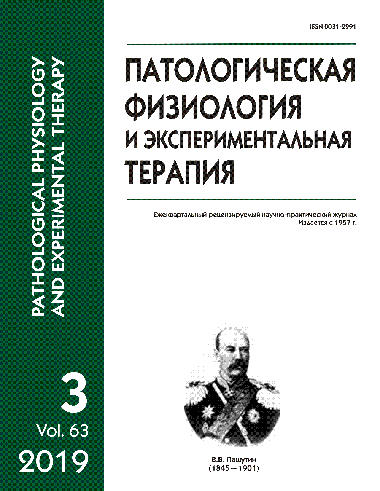Age and gender characteristics of indicators of systemic endotoxinemia and their relationship with generally accepted laboratory risk factors for atherosclerosis
Abstract
Atherosclerosis is a polyetiologic disease. In recent years, much attention has been paid to the role of the microbiota in atherogenesis from the perspective of inflammatory theory. Based on experimental and clinical data, the endotoxin theory of atherosclerosis was formulated. Confirmation of the important role of intestinal lipopolysaccharide in atherogenesis is the age dynamics of systemic endotoxemia parametrs and lipid profile. The goal of our study was to identify the relationship between the indicators of systemic endotoxemia and the generally accepted risk factors for atherosclerosis, especially the age dynamics and the influence of gender. Methods. We examined 113 patients middle age. All patients were assessed for risk factors for atherosclerosis according to the SCORE scale. Patients were assigned to the average risk group (up to 5%), rated themselves as “healthy”, did not present any complaints at the time of the survey. The body mass index was up to 30 kg/m2. Indicators of the lipid profile were determined (“StatFax” 3300 analyzer, USA, “Analyticon” reagents, Germany): the level of total cholesterol, high-density lipoprotein and triglyceride levels, the atherogenic index and the concentration of low-density lipoprotein were calculated. The parameters of systemic endotoxemia were determined: the concentration of lipopolysaccharide using a micro-LAL test, the level of antibodies to the hydrophobic and hydrophilic parts of the lipopolysaccharide molecule using the “SOIS-ELISA” method. Results. A direct significant correlation was found between the concentration of total cholesterol, low-density lipoprotein and high-density lipoprotein, depending on age. When constructing a regression model of the age dynamics, the concentrations of lipopolysaccharides, antibodies to the hydrophobic and hydrophilic parts of the lipopolysaccharide molecule were not detected (p> 0.05). When adjusted for gender, the age dynamics of systemic endotoxemia was also not observed. When visually assessing the graphs, attention is drawn to the fact that women have an age-related tendency to increase the level of lipopolysaccharide and a decrease in the concentration of antibodies to the hydrophilic part of the lipopolysaccharide molecule. In addition, gender differences in lipid profile and lipopolysaccharide levels were found. Conclusion. The significant age-related dynamics of the lipid profile in the presence of a tendency to an increase in the level of lipopolysaccharide and a decrease in the concentration of antibodies to the hydrophilic part of the lipopolysaccharide molecule, which has certain gender differences, revealed the necessity and feasibility of continuing research with an increase in the number of subjects and in the extended age range.






